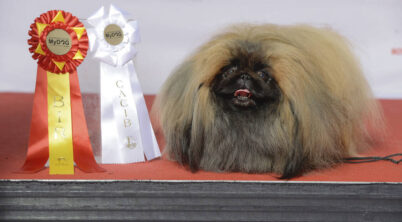When a Pekingese is expecting puppies, recognizing the signs of pregnancy can be important for providing the right care. One of the initial indicators of a Pekingese pregnancy is a change in nipple color and size. The dog’s nipples may become a rosier hue and more prominent approximately 2 to 3 weeks into pregnancy. Additionally, physical changes in the dog’s body, such as a slight swelling of the belly and enlarged breasts as the pregnancy progresses, can suggest that puppies are on the way.
As the gestation period for a Pekingese lasts around 57 to 65 days, observing behavioral changes can also be telling. A pregnant Pekingese might show signs such as nesting behavior, which includes actions like pacing and digging, as the time for delivery approaches. Closer to the due date, milk production typically begins, and in the final 24 hours before labor, the dog’s rectal temperature may drop below 100°F.
Careful monitoring and a good understanding of these signs can help ensure that a pregnant Pekingese receives appropriate support throughout her pregnancy and into labor. These signs not only aid in confirming pregnancy but also in preparing the owner for the arrival of newborn puppies.
Table of Contents
Recognizing the Signs of Pregnancy in Your Pekingese
If a Pekingese owner suspects their dog may be pregnant, they can observe several signs indicative of pregnancy. These include both physical changes and behavioral alterations that emerge as the pregnancy progresses.
Physical Changes: As the Pekingese advances through gestation, noticeable changes can include enlargement and darkening of the nipples, referred to as “pinking up.” This typically occurs around 2 to 3 weeks into the pregnancy. Furthermore, abdominal enlargement becomes evident as the puppies grow, though due to the small size of the breed, this may not be as noticeable until the later stages of gestation.
Behavioral Changes: A pregnant Pekingese might exhibit increased restlessness or may start nesting by seeking a safe and comfortable place for the delivery of her puppies. She could also show changes in her appetite, often experiencing an increase as she is nourishing not only herself but her developing litter.
In the latter stages of pregnancy, a significant sign is the drop in the dog’s rectal temperature. Typically, a decline below 38°C (100°F) suggests that labor could commence within approximately 24 hours.
- Key Behavioral Changes
- Increased restlessness
- Nesting behaviors (digging, pacing)
- Appetite fluctuations (often an increase)
- Physical and Medical Indicators
- Nipple enlargement and color change
- Abdominal growth
- Temperature drop before labor
Monitoring these signs can assist a Pekingese owner in preparing for the whelping process. It is crucial to provide a tranquil environment and proper care as the due date approaches to ensure the health and well-being of the mother and her puppies.
Understanding Your Pekingese’s Health during Pregnancy
During pregnancy, a Pekingese’s health should be monitored closely to ensure the well-being of both the mother and the puppies she is carrying. Regular check-ups with a veterinarian are vital to track the progress of the pregnancy and catch any potential health concerns early.
Pregnant Pekingese dogs may exhibit certain signs indicating that they are expecting, such as changes in appetite or behavior. It’s critical to maintain proper nutrition; a diet that’s appropriately balanced for pregnancy will support the mother’s health and the growth of the puppies.
Health screenings during pregnancy might include ultrasounds or X-rays to assess the development of the puppies as well as other diagnostic tests recommended by the vet. These help to ensure there are no complications and provide a glimpse into the size and health of the litter.
Table 1: Pekingese Pregnancy Health Checklist
| Week of Pregnancy | Health Considerations |
|---|---|
| 1-3 | Confirm pregnancy, begin prenatal vitamins |
| 4-6 | Increase nutritional intake, monitor weight gain |
| 7-9 | Prepare for birth, final vet check-up |
A significant drop in rectal temperature might indicate that labor is imminent, usually occurring 24 hours before the birth. Expectant Pekingese may also engage in nesting behaviors such as pacing or digging.
It’s crucial for owners to work with their vet to outline a pregnancy plan, including a birthing strategy and potential intervention methods if needed. Observing and adjusting care throughout the Pekingese’s pregnancy will help ensure the health and safety of the mother and her puppies.
Breeding and the Reproductive Cycle of a Pekingese
The Pekingese dog breed has a distinctive reproductive cycle that owners should understand if they are considering breeding. The reproductive cycle, which includes the phases of proestrus, estrus, and diestrus, is crucial for timing mating appropriately.
Proestrus is the beginning stage, where the female starts to attract males but is not yet receptive to mating. This phase typically lasts for about 9 days.
Estrus follows, which is the period when the female is receptive to the male and ovulation occurs. It is the optimal time for breeding, lasting approximately 9 days as well. During estrus, Pekingese females are most fertile and the actual mating process should be planned.
Diestrus marks the end of the fertile phase and the beginning of pregnancy or a rest period if mating has not occurred.
The entire heat cycle occurs about twice a year and can last from 18 to 24 days. Recognizing the signs of estrus is important for successful breeding.
Regarding the gestation period, a pregnant Pekingese typically carries her litter for about 63 days before giving birth. Signs of pregnancy in Pekingese dogs can include changes in appetite, weight gain, and nesting behaviors. A drop in rectal temperature below 100°F can indicate that labor will commence within 24 hours.
When planning to breed Pekingese, it’s essential to monitor these cycles closely for the health of both the mother and the puppies she may carry.
Caring for Your Pregnant Pekingese
Ensuring the health and well-being of a pregnant Pekingese requires special attention to her environment, diet, and the preparations for the birth of her puppies.
Preparations for Whelping
A comfortable and secure environment is paramount for a Pekingese ready to whelp. They should be provided with a whelping box—a safe, enclosed space where she can give birth and care for her puppies. This box should be large enough to accommodate her and her litter comfortably but cozy enough to provide a sense of security. Line the whelping box with clean, soft bedding that should be changed regularly to maintain hygiene.
Nutrition and Exercise during Pregnancy
As her pregnancy progresses, a Pekingese’s nutritional needs will increase. She will require a well-balanced diet rich in proteins, fats, vitamins, and minerals to support the developing puppies and maintain her own health.
- Proteins: Essential for the growth of the puppies.
- Fats: Provide energy and help absorb vitamins.
- Vitamins: Vital for the development of the pups and the mother’s overall health.
- Minerals: Important for bone development and other bodily functions.
Moderate daily exercise is beneficial to help maintain her muscle tone and prevent excessive weight gain, but intensive activities should be avoided. Regular, gentle walks and play sessions in a secure and familiar environment are recommended.
The dog’s grooming regime should be maintained, but care should be taken to be gentle to avoid causing stress or harm to the pregnant dog. Regular brushing will help manage shedding and promote healthy skin and fur.
Pregnant Pekingese demands more attention to ensure they are not stressed, as stress can negatively impact both the mother and her puppies’ health. They should be monitored closely for any signs of discomfort or illness and taken for regular veterinary check-ups.
The Birth Process and Postpartum Care
When a Pekingese is ready to give birth, close monitoring is essential. The gestation period for a Pekingese is typically 63 days, but this can vary slightly. As labor approaches, one may observe a significant sign – a drop in the dog’s rectal temperature below 100°F (38°C), which typically indicates that labor will commence within 24 hours.
During the first stage of labor, the Pekingese may exhibit restless behavior, which includes pacing and digging. This is due to uterine contractions that begin the birthing process. Owners should watch for these behaviors and prepare for the whelping, or delivery of the puppies.
Postpartum Care:
| Postpartum Stage | Care Required |
|---|---|
| Immediate | Ensure the mother is comfortable and the environment is calm to facilitate a smooth labor process. |
| After Delivery | Monitor the mother for any signs of distress and help with the puppies, if necessary. |
| Long-term | Provide nutritional support and maintain hygiene to promote recovery. |
The mother will require vigilant care after the puppies are born. The initial few hours post-delivery are critical for both her and the newborns. It’s imperative to ensure that the environment remains serene and comfortable to allow for necessary bonding and recovery.
A Pekingese’s postpartum period involves intimate care; the mother needs to be supported as her body returns to its pre-pregnancy state. This period typically spans 6 to 8 weeks post-birth. Throughout this phase, the owner should ensure the Pekingese is well-nourished and her health is regularly monitored by a veterinarian.
Observing and assisting a Pekingese through labor and the postpartum period demands dedication. Proper knowledge and preparation play crucial roles in the successful breeding and rearing of healthy Pekingese puppies.








